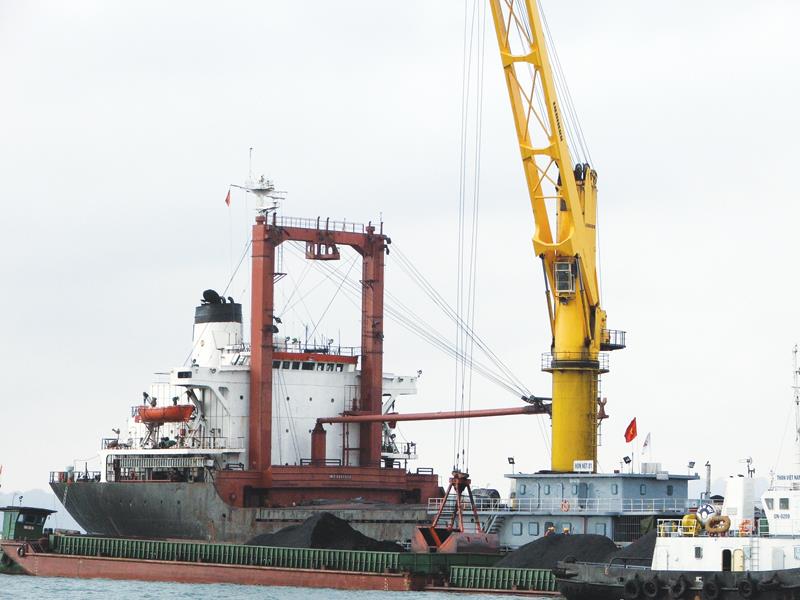MoIT proposing to import coal
 |
| A shipment of imported coal arriving to Hon Net Port, Quang Ninh province |
| RELATED CONTENTS: | |
| Coal to remain vital part of energy mix | |
| Trump signs order to roll back Obama's climate measures | |
| Vinacomin must shape up: Deputy PM | |
Miniscule ROE sounds the alarm
According to MoIT’s latest overall evaluation of the production, import-export, and supply of coal in the country, the ROE of two major enterprises in the coal industry has been plummeting over the last six years.
In 2011, Vietnam National Coal-Mineral Industries Holding Corporation Limited (Vinacomin) and Dong Bac Corporation achieved 23.39 and 29.33 per cent of ROE, respectively. At the end of 2016, the ROE of the two companies was at 1.5 and 9.67 per cent.
There is significant fluctuation in the profit of the two large companies. Vinacomin’s pre-tax profit in 2011 was VND8.663 trillion ($406.78 million), falling to VND850 billion ($40.375 million) in 2016. While the pre-tax profit of Dong Bac Corporation in 2011 and 2016 was VND302 billion ($14.345 million). However, its pre-tax profit decreased to VND178 billion ($8.455 million) in 2013.
During this period, Vinacomin’s commercial coal production decreased from 40.33 million tonnes in 2011 to 37.43 million tonnes in 2016. Dong Bac Corporation showed slight fluctuations with 4.16 million tonnes in 2011 and 4.56 million tonnes in 2016.
According to Deputy Minister of Industry and Trade Do Thang Hai, now and in the years to come, most coal mines will be exploited deeper and further, which makes it increasingly dangerous and risky. The investment rate per tonne at pit coal mines increased from $50 in 2000 to $150-180 per tonne today.
The amount of barren dirt or rock that has to be removed in order to get a tonne of coal has significantly soared. In 1995 the rate was 3.41 cubic metres per tonne, while in 2016 it was as high as 10.6 cubic metres per tonne.
“The high cost of mining has led to increasing costs in coal production, leading to the high inventory of domestically produced coal. This has affected the stability of production and accumulation to invest in exploration, improvement and expansion of existing mines, and investment in new mines, especially when the coal demand for electricity production is expected to increase rapidly after 2017,” said Hai.
Hefty increase in coal import
In 2016, the total amount of domestically exploited and imported coal surged to 52.8 million tonnes, a surge of 12.3 million tonnes compared to 2015, including 40.2 million tonnes of domestically exploited coal and 12.6 million tonnes of imported coal. More than 33 million tonnes of the total coal consumption in 2016 was reported to go for electricity production.
The number of coal-fired power plants will increase, leading to a hefty increase in the demand for imported coal for electricity production in the coming time.
According to Tai Anh, vice president of Vietnam Electricity, the coal demand for electricity production in 2016 was 33.2 million tonnes. This number is expected to increase to 68.4 million tonnes by 2020 and 132 million tonnes by 2030. Imported coal will increase from less than two million tonnes in 2016 to 24.4 million tonnes by 2020 and sharply to 85.2 million tonnes by 2030.
The Ministry of Industry and Trade cited the World Bank’s prediction that the price of coal (under Free on Board conditions) will go up to $72 per tonne in the Australian market during the period 2016-2020, and $81 per tonne during the period 2021-2025. If the additional cost of transporting coal to Vietnam is calculated at $15 per tonne, the price of imported coal in Vietnam will be $87 per tonne during the period 2016-2020 and $96 per tonne in the following five years.
Meanwhile, in order for the coal industry to make after-tax profit, and reciprocal capital of at least 15 per cent in any investment, the minimum domestic coal price in 2016 -2020 will be $80 per tonne and $85 per tonne in 2021-2025.
Some countries are shutting down coal-fired power plants and the possibility of increasing world coal supplies is a distinct possibility.
“As domestic coal mining needs to go deeper than before, costs are mounting, along with the risk of unsafe mining practices and negative environmental impact. Domestic mining companies are hard-pressed to compete with imported coal. This would be an ideal time to switch to imported coal and reduce the pressure on domestic production,” said Hai in the latest report.
What the stars mean:
★ Poor ★ ★ Promising ★★★ Good ★★★★ Very good ★★★★★ Exceptional
Latest News
More News
- Hanoi symposium highlights gender equality research and policy (December 03, 2025 | 12:00)
- Germany and Vietnam discuss development cooperation (December 02, 2025 | 20:39)
- Vietnam to limit raw rare earth exports (December 02, 2025 | 17:08)
- Japanese embassy marks 20 years of Japan-ASEAN bond market support (December 02, 2025 | 16:57)
- Roadmap unveiled to tighten vehicle emission standards (November 29, 2025 | 09:00)
- Technology and green finance emerge as twin pillars for Vietnam’s sustainable growth (November 28, 2025 | 10:52)
- Experts weigh in on Vietnam’s sustainability progress and future priorities (November 27, 2025 | 18:51)
- Green manufacturing insights and transformations: SABECO’s path to industry leadership (November 27, 2025 | 14:35)
- Siemens leads technology transformation towards sustainability in Vietnam (November 27, 2025 | 12:29)
- Hanoi workshop targets market access for women-owned firms (November 27, 2025 | 09:00)

















 Mobile Version
Mobile Version